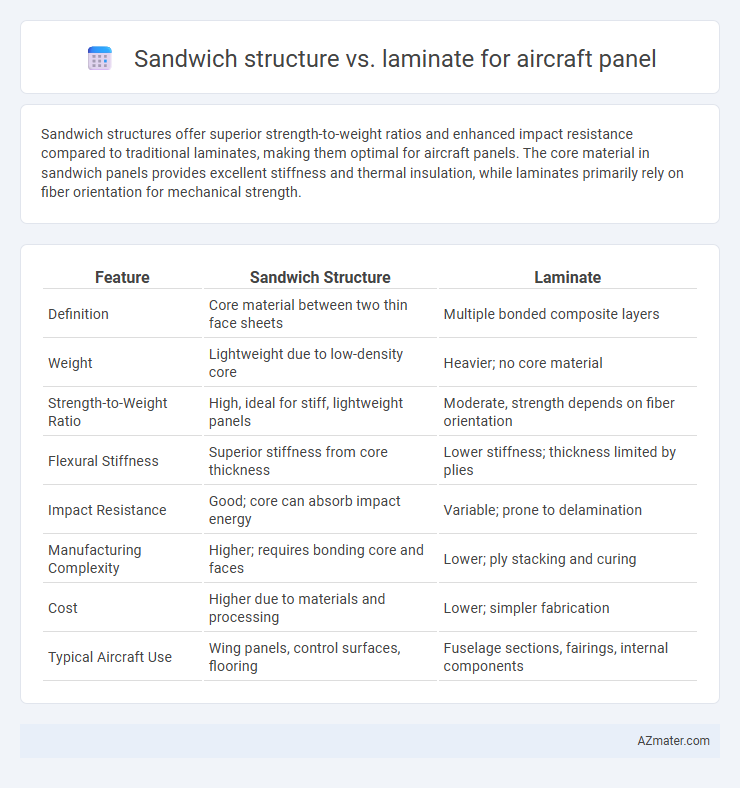Sandwich structures offer superior strength-to-weight ratios and enhanced impact resistance compared to traditional laminates, making them optimal for aircraft panels. The core material in sandwich panels provides excellent stiffness and thermal insulation, while laminates primarily rely on fiber orientation for mechanical strength.
Table of Comparison
| Feature | Sandwich Structure | Laminate |
|---|---|---|
| Definition | Core material between two thin face sheets | Multiple bonded composite layers |
| Weight | Lightweight due to low-density core | Heavier; no core material |
| Strength-to-Weight Ratio | High, ideal for stiff, lightweight panels | Moderate, strength depends on fiber orientation |
| Flexural Stiffness | Superior stiffness from core thickness | Lower stiffness; thickness limited by plies |
| Impact Resistance | Good; core can absorb impact energy | Variable; prone to delamination |
| Manufacturing Complexity | Higher; requires bonding core and faces | Lower; ply stacking and curing |
| Cost | Higher due to materials and processing | Lower; simpler fabrication |
| Typical Aircraft Use | Wing panels, control surfaces, flooring | Fuselage sections, fairings, internal components |
Introduction to Aircraft Panel Construction
Aircraft panel construction relies heavily on advanced materials to balance strength, weight, and durability. Sandwich structures, featuring lightweight cores such as foam or honeycomb sandwiched between composite facings, offer superior stiffness-to-weight ratios and impact resistance compared to traditional laminates. Laminates, composed of multiple bonded composite layers, provide high strength and tailorability but generally exhibit higher weight and lower impact tolerance than sandwich configurations.
Overview of Sandwich Structures
Sandwich structures in aircraft panels consist of two thin, strong face sheets bonded to a lightweight core, providing high stiffness-to-weight ratios essential for aerospace applications. The core materials, often honeycomb or foam, reduce weight while maintaining structural integrity and improving impact resistance compared to solid laminates. This configuration enhances load distribution and vibration damping, making sandwich panels ideal for lightweight, high-performance aircraft components.
Fundamentals of Laminate Structures
Laminate structures in aircraft panels consist of multiple bonded layers with varying fiber orientations, optimizing strength and stiffness while controlling weight. These structures provide tailored mechanical properties through anisotropic behavior, allowing engineers to enhance fatigue resistance and impact tolerance crucial for aerospace applications. Unlike sandwich structures that use cores for stiffness, laminates rely on fiber-matrix composites to achieve load distribution and structural integrity.
Comparative Weight Analysis: Sandwich vs. Laminate
Sandwich structures in aircraft panels offer significant weight savings compared to traditional laminates due to their core materials, such as foam or honeycomb, which provide high stiffness-to-weight ratios. Laminates, composed of multiple fiber-reinforced layers, tend to be heavier since they rely solely on resin and fiber thickness for strength without a lightweight core. The reduced mass of sandwich panels enhances fuel efficiency and payload capacity, making them preferable in aerospace applications prioritizing weight reduction.
Mechanical Performance and Strength
Sandwich structures for aircraft panels offer superior stiffness-to-weight ratios compared to traditional laminates, significantly enhancing mechanical performance under bending and shear loads. The core material in sandwich panels effectively absorbs energy and distributes stress, providing improved strength and damage tolerance over monolithic laminates. While laminates excel in fiber-directional strength, sandwich panels deliver enhanced impact resistance and fatigue durability crucial for advanced aerospace applications.
Durability and Damage Tolerance
Sandwich structures in aircraft panels offer superior durability due to their lightweight core materials, which effectively absorb impacts and distribute loads, enhancing damage tolerance compared to traditional laminates. Laminates, composed of stacked fiber-reinforced layers, provide high strength and stiffness but can be more susceptible to delamination and impact damage over time. The inherent core of sandwich panels improves resistance to fatigue cracks and impact damage propagation, making them preferable for applications demanding extended service life and maintenance reduction.
Manufacturing Processes and Costs
Sandwich structures in aircraft panels consist of lightweight cores bonded between two thin face sheets, requiring advanced bonding and curing processes that increase manufacturing complexity and initial costs compared to laminates. Laminate panels, typically made from stacked composite plies, offer simpler fabrication through layup and autoclave curing, resulting in lower production costs but potentially higher weight and reduced stiffness. Cost-efficiency in manufacturing favors laminates for small batches, while sandwich structures provide superior strength-to-weight ratios essential for high-performance aerospace applications despite the higher upfront investment.
Applications in Modern Aircraft Design
Sandwich structures, featuring a lightweight core material bonded between two thin face sheets, offer superior stiffness-to-weight ratios and impact resistance, making them ideal for aircraft skins, control surfaces, and floor panels. Laminates, composed of stacked composite plies with tailored fiber orientations, provide enhanced strength and damage tolerance, commonly used in primary structural components such as wing skins and fuselage frames. Modern aircraft design integrates both technologies to optimize weight savings, structural integrity, and fuel efficiency across various airframe sections.
Inspection, Maintenance, and Repair Considerations
Sandwich structures in aircraft panels offer enhanced damage tolerance and straightforward inspection through non-destructive testing methods like ultrasonic and thermography, while laminates require more detailed inspection to detect delamination and matrix cracks. Maintenance of sandwich panels involves careful core integrity checks and skin-to-core bond assessments, whereas laminates demand close monitoring of fiber orientation and resin condition to prevent structural degradation. Repair procedures for sandwich structures focus on core replacement and patch bonding techniques, contrasting with laminates that often require layer-by-layer restoration to maintain mechanical properties and load distribution.
Future Trends in Aircraft Panel Materials
Future trends in aircraft panel materials emphasize the integration of advanced sandwich structures with high-performance core materials and multifunctional laminates that enhance strength-to-weight ratios and improve damage tolerance. Innovations in nanomaterials and thermoplastic composites are driving the development of lighter, more durable panels with improved thermal and acoustic insulation properties. These advancements support sustainable aviation goals by reducing fuel consumption and increasing the lifespan of aircraft components through enhanced repairability and recyclability.

Infographic: Sandwich structure vs Laminate for Aircraft panel
 azmater.com
azmater.com